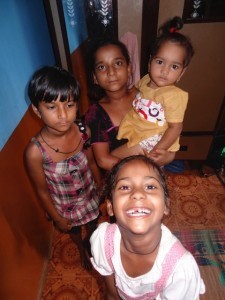Lisa Niver's Blog: We Said Go Travel, page 442
December 14, 2013
Curated Quotes: 40 Best Travel Quotes from 40 Bloggers
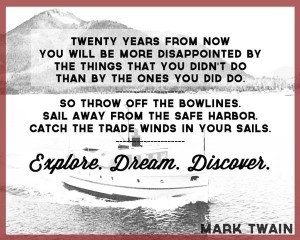 Thank you to Curated Quotes for including us in
Thank you to Curated Quotes for including us in
THE 40 BEST TRAVEL QUOTES ACCORDING TO THE 40 BEST TRAVEL BLOGGERS
Who better to weigh in on the best travel quotes than the bloggers and travel writers that live and breathe travel every day?
I reached out to some of the most well respected travel blogs with a simple question:
What is your favorite travel quote?
See the results rendered in beautiful technicolor.
If you’re not already infected with wanderlust, these quotes will have you packing your bags and heading to the train station. Bon Voyage and thank you to all the travel writers that participated. I hope to cross your path some day.
Click here to see all the quotes!
I wonder which is your favorite. There are so many GREAT quotes! I like this one from Eleanor Roosevelt: “The purpose of life, after all, is to live it, to taste experience to the utmost, to reach out eagerly and without fear for newer and richer experiences.” We hope to see you on the road!
The post Curated Quotes: 40 Best Travel Quotes from 40 Bloggers appeared first on We Said Go Travel.
Sri Lanka: Pigeon Island
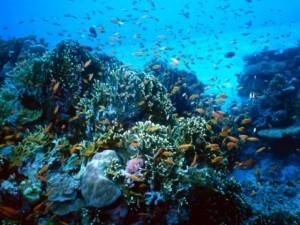 Rain welcomed us. It was as though, all my stress and tiredness was washed away by the rain. From the moment I landed there to the time I came back, I felt peace; within and outside. The beauty was beyond anything I had dreamed about.
Rain welcomed us. It was as though, all my stress and tiredness was washed away by the rain. From the moment I landed there to the time I came back, I felt peace; within and outside. The beauty was beyond anything I had dreamed about.
Sri Lanka was a miracle to me. From its beautiful landscape to the scenic rivers, from centuries old relics to the modern day buildings, from the delicious foods to the amicable people, the picturesque country made me fall in love with it again and again. I never understood Woods worth’s line, “a thing of beauty is a joy forever”, better than the time I vacationed at Sri Lanka.
It was a colorful ride. To me, Sri Lanka is a lot of things. It is the cultural dance at Kandy, the sweet girl at Nuwera Eliya who offered me flowers near a water fall, the Banana ride at Bentota, the Cave Temple at Dambulla, the serenity in the Buddhist temples and the sense of elation at reaching the top step of the Lion Rock.
The best part, however, was not on land. It was rather a venture into the deep blue sea. I have always been hydrophobic. I like going to the beach but if the tides are high, I restrict myself to a bench and just enjoy the view. My husband, on the other hand, is hydrophilic!! During our stay at Trincolmalee, he was overjoyed to know that we can go for Snorkeling. Basking in the love of a newly-wed, I couldn’t refuse and went along. Now I love him more for the experience.
A boat took us to the Snorkeling sight at Pigeon Island. The scenes were so breathtaking that I forgot my fears for a while. But the minute I was told I am about to be rolled into water, the idea shook me to the core and made me wonder if I was mad to have agreed to come here. I stood still as the guides prepared me with the snorkeling kit and wet suit, which consists of a mask and an oxygen kit that goes into your mouth for breathing – a simple mechanism. I was told not to worry about the fancy gadgets as the caretaker would take care of all that.
The moment they told me that I was about to be rolled into the water, my heart started beating wildly. On the count of three, I was falling on my back, holding my mask, looking at the sky and splash! For a second, I was overwhelmed by the fear of the unknown.
There was a moment of panic during which I couldn’t breathe properly, but the instructor soon fixed my kit. He kept me on the surface for a while after that so I could regain my confidence. Soon, the curiosity to discover the underwater world overcame my fear. The moment I dipped my head in, I congratulated myself for my courage.
The scenes under the water were breath taking. The refraction of light and green vision, startling at first, soon started to look spectacular. My gaze began to wander as far out as it could trying to grasp the entire beauty of the scene all at once. Fish traveling in shoals moved so close to me that I could almost touch them with my hands.
There was a kind of silence that words can’t explain, a sense of total tranquility and peace. I lost track of time, forgot that I didn’t belong there. I was in a trance. I came back to my senses when the instructor said we had to go back to the surface. He was surprised when I refused. After a few moments, he asked me again and despite my reluctance, I had to come up. As soon as my head hit the surface, I yelled: “I want to do this again!
If it is one thing that everybody should get a chance to do on vacations, it is definitely a dip in the water. The deeper you are, the higher you go! Although all places in Sri Lanka give each other a touch competition in being the best but to me, nothing could beat the beauty beneath water. Happy Snorkeling travelers!!
About the Author: A banker by profession and a writer by choice. Twitter: @syedaerumfatima
The post Sri Lanka: Pigeon Island appeared first on We Said Go Travel.
December 13, 2013
India: Trip to Corbet with Friends
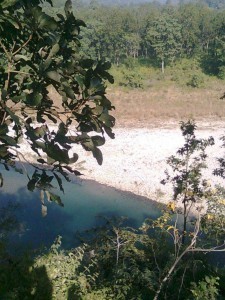 Corbett was always a special place for me as I had celebrated my three birthdays at Jim Corbett, but this time it was different. For the first time in my life, I was going to a place far away from Delhi (where I live) without my family. I was only 10. Our school “PRESIDIUM” planed this educational trip for us. In this trip, I also had with me my best friend Shivansh, whom I also call Shivu. We started our journey from our school in Delhi at around 8 am in the morning by bus. Finally, after a long journey of 6 hours, we reached our destination – the Corbett!
Corbett was always a special place for me as I had celebrated my three birthdays at Jim Corbett, but this time it was different. For the first time in my life, I was going to a place far away from Delhi (where I live) without my family. I was only 10. Our school “PRESIDIUM” planed this educational trip for us. In this trip, I also had with me my best friend Shivansh, whom I also call Shivu. We started our journey from our school in Delhi at around 8 am in the morning by bus. Finally, after a long journey of 6 hours, we reached our destination – the Corbett!
I had already visited the Corbett around 10 times, but the place looked new and more beautiful this time. Our school had booked the Manu Maharani Resort, a luxurious and comfortable resort by the side of the Kosi river. The resort was surrounded by thick, green forest and I could notice a large variety of birds all around. The staff of the resort was quite courteous and they warmly welcomed us to the resort. After we put our luggage in the rooms and freshened up, it was time for something big and dangerous. I mean RIVER CROSSING.
The river was very wide and the speed of flow was too much for us. On top of that, the water was too cold. In the winter season, you surely would not want to swim in cold water. After some initial hesitation and fear, I and my friends finally did it successfully. I was very proud after crossing the river not only once, but thrice! I also got the punishment for it, not by the teachers but by God. I had caught cold by the time I returned to the resort. But after having some hot pepper soup, I was much relieved and till the next morning, I was perfectly fine.
Next morning, at 4:00am, we went for trekking and as we trekked higher up the mountain, our view kept on improving. After about an hour of walking, we had completely left the noisy area and were on the top of a mountain of an average height. The view from there took my breath away. It was so amazing and serene. After sometime, we saw a peacock in the bushes. The pleasant weather, the silence, and the view were all just perfect. Today, even after 3 years of the incident, I still remember the exact view because the view and the peace of the place is not stored in my brain but in my heart.
We had planned to sleep in tents the second night. Each tent was to accommodate three children; so, I had two of my friends in the tent with me. Unfortunately, Shivu was not one of them because “who sleeps where” was decided by the teachers.
The forest, which looked so inviting during the day, was now looking horrifying in the dark. My roommates, or rather my tent mates, were too scared, as various sounds of dangerous animals were coming to our tent from outside. From my camping experience with my parents, I knew that animals will not come near us because of the fire that was lit outside the camp. However, I decided to play a prank on my tent mates and instead of consoling them and telling them the truth, I told them that it is not only the animals that they should be scared of, there are also ghosts here!
Listening to my words, they both became pale with fear. I started to scare them more and more by telling them some made-up ghost stories and when it was too much for them to take, they got up and ran away to another tent and slept there. They did not do this because they thought I was lying and scaring them but because they though they would be safer in a bigger group if ghosts came in the night. I have no doubt that they were unable to sleep well because no tent there had space for five children. But I got an independent tent for myself and invited Shivu to my tent, where we both slept very well!
The next day was again full of fun. We did trekking, had good food, and went for the jungle safari. The jungle was not new for me, as I had been inside the Corbett forest several times before. As usual, we saw lots of golden deer, sambar deer, peacocks, and other small animals. That night, we slept in the rooms, which must have been a great relief to my previous-night tent mates. Both of them slept very early, as they could hardly sleep the previous night. I chose to be generous this time and let them sleep peacefully.
Next day morning was the final day of our trip and we returned to our school by the evening. I and Shivu again had a lot of fun during the bus journey.
As all good things end, the trip was over and we were back to school and back to studies. But I sincerely thank my school and my teachers for this wonderful trip, which offered me so much of peace, fun, and adventure during the three days; though I cannot say for sure that my tent mates would agree with my assessment of the trip. May be I will ask them some day.
About the Author: AAKASH PANDEY: I am Aakash and I am 13 years old actually I just turned 13 this October. I live in India and my current story was about my school trip to Corbet. I want to do well in the field of English and want to be a writer one day.
The post India: Trip to Corbet with Friends appeared first on We Said Go Travel.
H1 and H2 Two Sides of the Same City: Hebron, Palestine
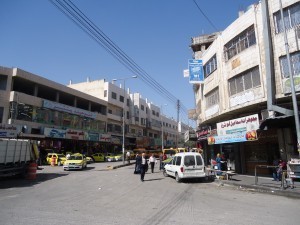
Downtown Hebron, but this city is divided and has been the flashpoint in the Israel – Palestine conflict for years.
Having grown up on the streets of Northern Ireland in the 1980s, cultural, political, religious and geographical divides have always been a part of my life. Whether I’ve wanted them to be or not. As my travel lifestyle has developed over time, I have become much more intrigued by the parts of the world that are sadly still experiencing war, hate and bloodshed and those trying to change from a history of problems and move on. Turning these problems into peace is every man’s dream. But the reality is, places like Hebron in Palestine are divided cities for a reason. Until you’ve been there, you don’t have a clue! So it was time to go…
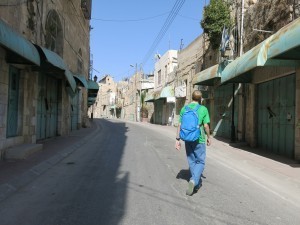
Backpacking in Hebron’s Apartheid Street with a political edge to the adventure.
So I was backpacking in Israel and Palestine and decided on a full day trip to Hebron as part of a tour that allowed us to spend half a day on both sides of the city – I’d get to experience what life as an Israeli and life as a Palestinian is like. Our bus left from Jerusalem main bus station and yes, the windows are protected and almost “bullet proof”. Just to put things into context here, the week before my visit to Hebron, an Israeli soldier was shot dead by a Palestinian sniper. This trip ain’t for the faint hearted. It’s an eye opener. In general though, it’s a safe enough trip and you’re advised to do it with a guide – besides you get a better insight into the situation with a local guide.
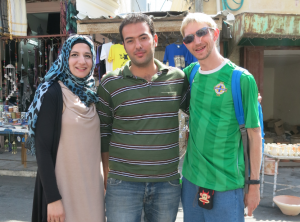
With a fellow traveller and Mohammed my guide for Palestinian Hebron (H1).
The special thing about my trip to Hebron was that I got into both sides of the divide, on a “double narrative tour” run by Abraham Tours (they are based in Jerusalem and highly recommended). I was with a Jewish tour guide taking me through the Israeli controlled section, and I was with a Palestinian tour guide taking me through the Palestinian controlled section. It was Palestine in the morning, and Israel in the afternoon, well so to speak. Locally, in English at least, the sides are known as H1 and H2, almost as a cover up for the fact the city’s name is Hebron. Or to be . I’d prefer if it was called Israeli Hebron and Palestinian Hebron though, as throughout the day I got confused as to which part was H1 and which was H2.
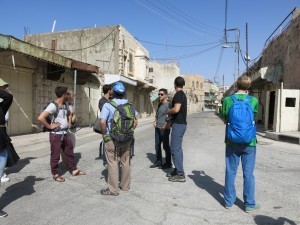
Our tour group assembles in Apartheid Street to begin the Hebron Tour.
To start the tour we get off the bus on Apartheid Street. Nice introduction. With a name like that I had flashbacks to my time in Soweto and Pretoria. Here though, the meaning is the same. It’s two separate religions or cultures, separated by a street which these days nobody lives in. And why would they? The street was evacuated some years ago due to the high tension. All the houses are boarded up, they have turquoise doors and the place hasn’t seen any dwellers since the 1990s. Currently, that’s the way it will stay. We leave our Jewish guide at this point, and head to H1. H1 is a Palestinian area only. Israelis are not allowed in. Let me explain…
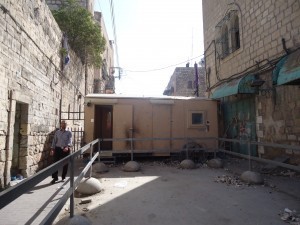
The border hut between H1 (Palestinian Hebron) and H2 (Israeli controlled Hebron).
Modern day Hebron is a Palestinian stronghold and houses a Palestinian population of 160,000 or thereabouts. There are also around 700 Israelis living in Hebron giving it that divided edge. These figures don’t include the Israeli army that man the city day and night – 24 hours a day this place is under Israeli army control. They’re all armed. It is illegal for the Palestinian soldiers or police to carry a gun. It is illegal for Israelis to enter H1. For these reasons, Hebron is split into two and referred to as two separate parts – H1 and H2. H1 is controlled by Palestine and H2 is controlled by Israel. However the borders are manned by Israeli soldiers. You can feel the tension in the air. You can see it with your own eyes.
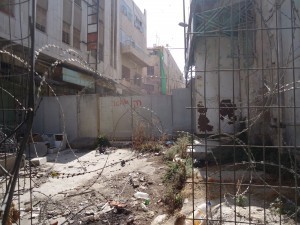
The border blockades between H1 and H2 in Hebron.
We meet our Palestinian guide Mohammed and are taken through a security hut which doubles up as the border between H1 and H2. We leave H2 and we are now in H1. We’re on a prominent corner in downtown Hebron but we take a walk down a side street again and back towards the border. Mohammed points out the dividing wall. It’s a dead end street with bricks, bottles, barbed wire and a notable gap between what you could describe as Israel and Palestine. This is a world border right here. Hebron is sadly a flashpoint in the conflict here and this becomes apparent.
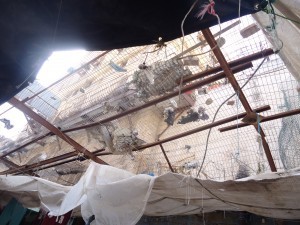
Above the market in H1, Hebron is proof of the bricks and litter thrown across the dividing line.
We are taken through the market to meet the locals. On route there’s a sign that the Palestinians are hemmed in. They don’t appear to have any freedom here. There are bricks on top of wire fencing over the market. It’s not pretty on the eyes. It’s a hard life for them here, that’s for sure. You don’t make stuff like this up just to show the tourists. The bricks have come from the Israeli side, but the locals refuse to surrender to their demands. We have coffee with a local guy who lives right on the border – he’s been through it all, ten times over. One of our tour group asks him why he doesn’t move to a new flat, when his children are at risk. He gives the obvious and expected answer “this is my home. I’m not moving”. He also admits that for $100,000 US Dollars he also wouldn’t move. These are Palestinian family homes and have been for generations. For now we side with Palestine.
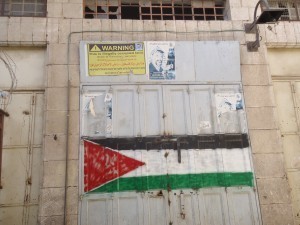
There are a few reminders that we are no longer in the “Israeli part”: This is Palestine.
We head into the Ibrahimi Mosque. this Mosque has security gates on the way in, and we are on the Palestinian side. The Mosque is also a synagogue. This building has an entrance for Jews and an entrance for Muslims. Even the religious buildings are segregated. Probably the saddest and most telling part of the entire tour. There was a shooting here in 1994 – while Muslims were praying a Jew walked in and opened fire.
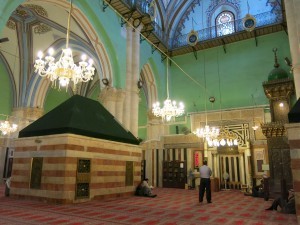
The marvellous interior of the Ibrahimi Mosque.
Inside its a holy Muslim place of worship, so we dress appropriately and take our shoes off. As we should and as you should too. However I get angry as I see a lot of disrespectful Jewish people walk on in, without removing their shoes, some of them even wearing shorts. I find it completely disrespectful to the Muslim religion. In a holy place. These Jews even have the audacity to take photos and laugh at the fact that Muslims are prayer. I’m a bit disturbed by it, as is Mohammed and most of our group.
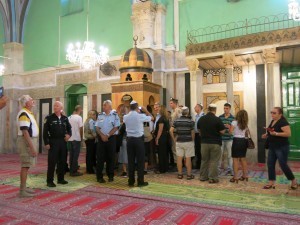
Some Jewish people came in and walked on the floor of the Ibrahimi Mosque on the H1 side without respecting the Muslim culture.
After this I buy some Palestinian coins in the local market for my collection. Palestinian banknotes are not available, and I have picked up some postage stamps in Bethlehem before. It feels like a different country. We head to a viewing tower which again shows how the Palestinians are denied freedom here. All around there a guard posts manned by Israeli soldiers. I thought of West Belfast for a second then realised – no, these people have no freedom, in West Belfast they do. It’s almost like their city has become a prison. For a Palestinian to escape their home town and go abroad is an arduous task. Getting to the border and into Jordan can take the best part of 11 hours.
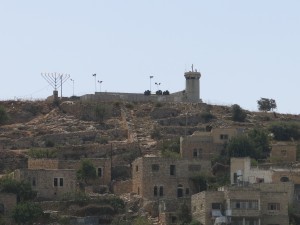
One of many Israeli watchtowers staring down at Palestinian controlled H1, 24 hours a day.
Lunch is served politely, courteously and in generous portions as we eat hummus, salad and chicken with a local Palestinian family. After lunch, we are “relaxed” back into H2, the Israeli controlled side of Hebron for our tour by the Jewish guy. This is where things get odd. We’re now seeing the same city for a different point of view.
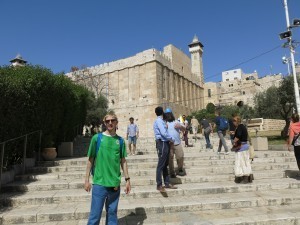
The exact same Mosque/Synagogue that I was in earlier, except this is from H2, the Israeli controlled side.
We walk into the same building we were in before (The Ibrahimi Mosque) and we are now in a synagogue with lots of Jews praying and reciting verses. There seems to be a denial or a disbelief that Jews viewed from the other side were wearing shoes and laughing at Muslims. I almost wanted to call Colombo (Peter Falk) and get him to investigate the case. Although, for today thankfully no homicide, just a mystery of conflicting views and opinions within the same building. Our Jewish guide insists this building belongs entirely to Jews and the Muslims shouldn’t be allowed to lay claim to it, as they took it illegally. Earlier we heard a similar tale from Mohammed our Palestinian Guide.
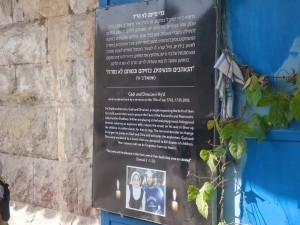
A plaque at a memorial of one of the deaths carried out by Palestinians in the area.
We head to the point in the road where last week a soldier was shot. It’s a poignant moment and for now, we side with the Israelis. it’s an emotional sectarian drama before our very eyes – and we came here as tourists. Another spot in the road was the scene of a horrendous suicide bombing, where Israeli children were killed some years ago. This is sad. We visit the memorial, which is still there. A Jewish synagogue is also here and in good condition. It’s survived some bad times.
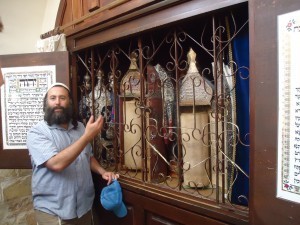
A synagogue in H2 – the Israeli controlled part of Hebron.
Murals on both sides seem to portray the exact opposite to one another. I have a chuckle at the “Free Palestine” and “Free Israel” signs. On a later trip to Bethlehem, I was also startled but not surprised to see the Israeli Jews being compared to Nazi Germans in a wall graffiti act bearing the Swastika. It’s interesting when you look at the world from someone else’s point of view. The Palestinians are the weak ones here – they’re enclosed in a vacuum.
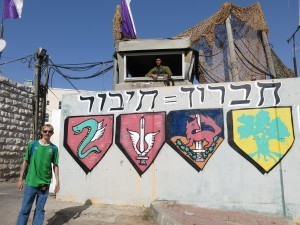
In front of one of the soldier checkpoints and viewing towers in H2 Hebron (Israeli controlled).
The Jews are in the major minority in Hebron, but we catch up with a local lady who has been through family deaths and lives a tough life. We totally side with her and later walk up to a guard post. The Israeli soldier there talks for 5-6 minutes. He has no fear in life. He shows us the exact location where the Palestinian sniper came from the previous week and killed one of his army colleagues. It’s a matter of life or death in parts of Hebron and it’s truly sad. Israelis find it hard to trust any Palestinian.
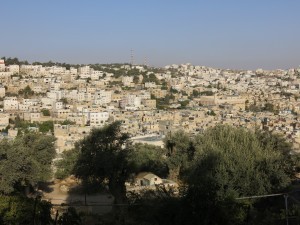
A decent view of Hebron from H2 (Israeli controlled side).
Our final part of the tour on the Jewish side takes us to the Jewish Museum, which I find biased. It completely only shows things from the Israeli side. There are no photos or mentions to the fact that the Palestinians are blocked in and controlled by the Israeli state who man the borders. Palestinians live here too and are good honest, hard working people for the most part. That’s the reality. But how can a tourist solve a problem which has been going on for years.
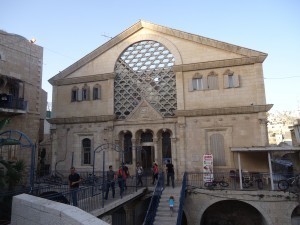
The Jewish Museum in Israeli Controlled Hebron (H2)
A tour of Hebron is one of the biggest eye openers from my travel journeys and completely educated me on the whole problems with the Israeli – Palestinian conflict. I also visited Ramallah, Bethlehem and Jericho in Palestine, but Hebron is the place to see things at first hand.
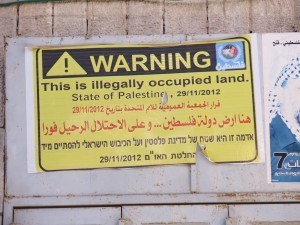
A warning notice on the Palestinian H1 side of Hebron.
It’s sad to see the divide and how the Palestinians are completely enclosed. Whether a two party state or a one party state is the best option for peace, one thing’s for sure, closing people off from fellow humans is in itself absurd and inhumane. My heart goes out to everyone in Hebron. I highly recommend this to anyone visiting the region. By far this trip was more interesting than Masada, Akko, the Dead Sea and Nazareth.
To the people of Hebron, “Your destiny will keep your warm”
Peace, love and safe happy travels to one and all.
The post H1 and H2 Two Sides of the Same City: Hebron, Palestine appeared first on We Said Go Travel.
India: Where in the World
Somewhere. a girl steps off a plane and into a world unknown.
Sometime. a boy runs barefoot through dirt streets, late.
Somewhere far away from here, a girl is assaulted by the new world around her. In the back streets of the old city, the country finds her. Senses are excited to the point of explosion. Smells of frying chapatis and smouldering spit and incense and putrid water. Sounds of horns. horns. horns. Never-ending, like one eternal blast from an old tuk tuk, magnified to be heard even in the farthest corner of the country. Sights of rickshaws carrying wardrobes squeezing between oxen pulling carts and people carrying mountains of produce on their heads. Feel the dirt that hangs in the air caress her skin and slowly darken it to meet the colour of locals with every building layer. Feel the heat burn into her chest, the sweat begin to stick. Taste the colours in the curries, greens and oranges and reds alive and vibrant. To be embraced.
Welcome to somewhere like nowhere else.
Sometime a boy’s light feet can be heard padding the pavement, as he runs through a maze of small square houses, late for lessons. He breathes heavily as he ducks under clothes drying in the fierce sun. He turns a sharp corner, jumps over the pile of shoes at the door and bursts into the room full of children. A family’s living-bed-dining-room-turned-classroom for a few hours a day. Hospitality is like heat in this place, everywhere and enveloping. Panting, he backtracks to stand by the rusty old door, broken on its hinges, to ask,
“May I please enter didi?”
Only to be met by a tidal wave of stern words, chastising his tardiness. He stands tall and waits for the words to leave through the door he had come. And when they do, he sits on the straw mat, squeezing between two classmates, heading the threat that if late again, he is out for good.
Welcome to the world where knowledge is more precious than gold.
The girl watches a rusty bus squeeze past her tuk tuk. Everyone going everywhere, carrying a story. A million lives, billions of stories moving around her in a blur. And hers is but one. She scribbles moments on a napkin; her story written as she lives it. Whilst others are lost in the din of city traffic, driving away into silence.
She returns to the airport, flys south. Escaping the city and being engulfed by the humidity of the beach. Quiet by comparison, the small village welcomes her with smiles and sweat. Sweat. Sweat.
She steps into the classroom and into a home. A small, cool room with an old TV in one corner and a wobbly wardrobe in another. The family’s bamboo mats have been rolled up and lean against the wall, and they roll out our own. One simple swap turns a bedroom to a classroom. She sits, and waits for the children to arrive, exhilarated in anticipation. The first through the door is a small boy in long pants, a shiny watch hanging from his wrist.
She smiles, takes a deep breath of humid air, and starts the day’s lesson.
Somewhere. A girl finds hope in the eager eyes of a child.
Sometime. A boy finds happiness in the knowledge shared by an unknown alien-girl.
In a place of 1.2 billion people, stories come and go faster than what time can collect. Some are forgotten. Some scream louder than the horns that fill the air.
These are but two.
Stories of hope. Hope for the future. Hope for happiness. Hope for change.
For in a place where billions of people squeeze to fit their lives side by side, there is one underlying piece of magic that they all share.
It fills the air, and lights even the darkest places with its engulfing mist.
Soaking through skin, slipping in windows, ticking with every second of a too-big-borrowed watch.
It is present. Always.
An undying, undeniable, inescapable feeling of hope.
About the Author: Tamara Lennon: My love of travel and writing intertwine and carry me to the most beautiful people and places on earth. We have so much to learn, and so much to discover. So pack your bags and get going- and don’t forget a pen and paper!
The post India: Where in the World appeared first on We Said Go Travel.
Nigeria: Discovering Akoo
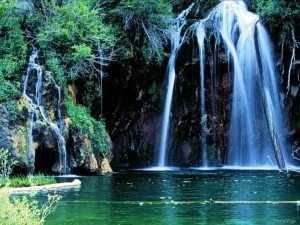 It was a very long journey travelling from Abuja to my hometown. I was only six years old. We arrived at the village at about 3:30pm. ‘Big Mama’ as we fondly called my grandmother was there to give a warm reception. Exchange of pleasantries with relatives and other neighbours with series of ‘welcome’ that filled the air was next. Grandma served a sumptuous meal. It was actually a rare delicacy.
It was a very long journey travelling from Abuja to my hometown. I was only six years old. We arrived at the village at about 3:30pm. ‘Big Mama’ as we fondly called my grandmother was there to give a warm reception. Exchange of pleasantries with relatives and other neighbours with series of ‘welcome’ that filled the air was next. Grandma served a sumptuous meal. It was actually a rare delicacy.
Suddenly, I innocently broke the ‘mealtime silence’.
“Daddy, remember you promised to take me to the village river.” I said in my tiny voice.
“Yes, we’ll go this evening so that we can be able to leave for the city very early tomorrow morning.” He replied. That was exactly what I wanted to hear. I responded immediately with smiles.
Dad beckoned on me after the meal and now we’re set to go on my ‘anticipated adventure’.
After some minutes of walking in a fairly narrow road with Dad holding my hand firmly as we walked slowly down the fairly slippery rugged hill. The villagers were passing to and fro. Many of them were in groups and yet a few others walked on their own along the bushy path leading to the village river. The road was quite busy that lovely evening.
Imaginations were now building up in my head. I was trying to picture what the river looked like. Dad had once told me that the water continuously gushed out of a large stone ‘hanging in the air’. This boosted my enthusiasm as a young child full of eagerness to learn new things about my environment.
After walking for a few more metres I could now perceive the sweet scent of fresh water that filled the air. I was now hearing voices chattering in a distance. Sooner than I expected I beheld a beautiful scene. The village river was a wide one.
“This river is known as Akoo. The river is customarily divided into three zones: the left side is for the women, the right side is for the men, and then a central inner area which we’ll still explore.” Dad explained as I watched keenly.
The village river was fairly deep as we stepped in with Dad still holding my wrist firmly. The water almost got to my shoulders while it barely reached Dad’s waist. We had already removed our shirts and trousers which were carefully hung on tree branches on the river banks alongside our slippers. The experience was simply awesome. All my life then, I never knew people could bathe in such large waters without being drowned. I’ve never experienced ‘sinking and floating’ on such fast flowing waters.
Dad now told me to come with him to see the source of the water.
“Oh my God!” I exclaimed and asked immediately, “Daddy what is this?”
“A waterfall.” He answered smiling. I was thrilled at the sight. As young as I was then, I was so much scared of heights. Meanwhile, there were no tall buildings around our city house except the church tower in the centre of the town.
“What is that big stone up there?” I asked Dad pointing upwards. I saw waters forcefully gushing out from the huge mass of rock which seemed to be hanging in the air. The waters rushed out sliding through the cliff of the rock and poured down on the flowing river with powerful thrusts.
This natural spring serves as the major source of water for the community. The villagers with their water pots usually stand on the rocky base of the heavy downpour intercepting the waters as they rushed down thus filling up their vessels. I still observed the series of events going on with my young awestricken mind.
Dad had told me the myth about the place. The name of the waterfall, Akoo actually originated from the huge stone – the source which our ancestors worshipped as the god of fertility and vegetation. Little wonder the arena was filled with such aura and much glory was accorded to the river by the villagers, even till date.
Dusk was speedily setting in and I was still keenly observing the rock as the waters gushed out, watching from one crevice to another, admiring the green shrubs as they danced to the music the waters were playing.
“Let’s go.” Dad said tapping my back.
“Oh no…Not yet!” I cried. But he maintained that we have to go because nightfall was fast approaching.
We walked out into the open river once more, sweeping my legs against the tidal flowing streams. I was filled with fulfilment and excitement. We hurriedly put on our clothes; at last I can now tell my childhood friends something about my hometown. The waterfall really made my trip an admixture of bewilderment, awe and fun.
About the Author: I’m Prince Henry, a young Optometrist with Nigerian roots. I have die hard passion for writing and reading as well. You can reach me on Twitter.
The post Nigeria: Discovering Akoo appeared first on We Said Go Travel.
December 12, 2013
Ohio: A Thousand Miles Away
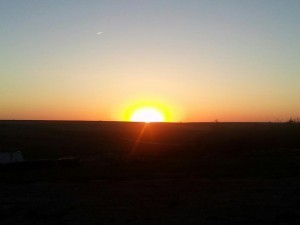 The rolling, green hills creep past my windows while I leisurely drive along the winding road, occasionally passing a pick-up truck. I have the local country station blasting as I sing along, “Makes me wanna take a back road. Makes me wanna take the looong waaay home.” This peaceful slice of countryside has a calming effect on me. It’s never changing. No matter how far away I go from this place, no matter what length of time I’m gone, it’s always exactly as I remembered it when I return.
The rolling, green hills creep past my windows while I leisurely drive along the winding road, occasionally passing a pick-up truck. I have the local country station blasting as I sing along, “Makes me wanna take a back road. Makes me wanna take the looong waaay home.” This peaceful slice of countryside has a calming effect on me. It’s never changing. No matter how far away I go from this place, no matter what length of time I’m gone, it’s always exactly as I remembered it when I return.
As the road curves around a sharp decline, I know exactly when to tap my brakes. This is the same road I drove down every day from the age of sixteen to eighteen. Back in those days, I couldn’t wait to get out of this town. It was almost stifling, how small it was. I didn’t know what to expect from the world beyond these county lines, but I knew that I had already seen everything within them.
It’s been five years since I have lived in this place permanently, and it seems further away than ever. During my college years, I would return here, and it would be as if I had never left. I could throw on some old clothes from my closet and go into town to meet my high school friends. I can no longer squeeze into the old jeans I wore when I was seventeen, and most of my high school friends are married with children and have long forgotten about me.
Or maybe I’ve forgotten about them.
My car starts to chug up the hill called Spring Mountain. When I was a child, I thought that Spring Mountain was the biggest mountain there was. I used to wonder if I would ever be able to walk all the way from the bottom to the very top. As the years have passed, I have walked up many mountains that are easily twenty times the size of this one. No, this place hasn’t changed. I’ve been the one to change.
I used to feel trapped here. I never appreciated the miles of endless trees or the quaint farmhouses or any of the things that most people have to drive an hour out of the city to see. I never felt the support of the tight-knit community. It seems that I never noticed the important things until I was stung by the absence of them.
I reach the top of the hill, and the road flattens out as I drive the last half mile to the place I lived for the first eighteen years of my life. I know exactly what to expect from this town and all the families that have lived here for generations. Everything appears to be the same, but it feels different. I feel welcomed here, but I don’t feel as if I belong.
After leaving this place, I traveled across the Atlantic Ocean, walked the entirety of the Appalachian Mountains, and drove out west to find a new place to live. I thought that I was only learning more about myself. I didn’t know that I was losing the person I had once been. This place that I was once so familiar with no longer feels like my home.
My tires crawl across the hot, interstate pavement. I stare at the Rocky Mountains in the distance, in a trance, wishing I was hiking over them instead of being stuck in traffic. I’ve been living in this city for months and I’m still not sure if it’s the place for me. I hear the guitar twang of a familiar song, and I turn the radio up and sing along, “Home is where my heart is still beating. I don’t know when I’ll see her again. I hate to see her cry when I’m leaving. But now I’m a thousand miles away again.”
I really am a thousand miles away from home. It seems like the more I try to see of the world, the more I am eluded by everything I left behind. I can’t have them both. Traffic starts moving again and I hit the gas, driving towards the horizon.
About the Author: Megan Maxwell is originally from Ohio, and currently resides in Denver. She hiked the Appalachian Trail from Georgia to Maine and has a how-to blog for women who are interested in backpacking. She hopes to one day be a full-time writer and to always continue having adventures.
The post Ohio: A Thousand Miles Away appeared first on We Said Go Travel.
A Cricketing Passage to India
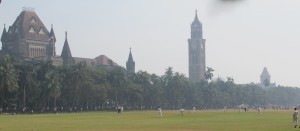 “Woooosshhhh” goes the sound of the red painted tennis ball as it flies past my head. The laughter from the boys standing nearby, when I swing my arms round and try to hit the ball that has already passed me is thunderous. Welcome to Indian cricket. Street style.
“Woooosshhhh” goes the sound of the red painted tennis ball as it flies past my head. The laughter from the boys standing nearby, when I swing my arms round and try to hit the ball that has already passed me is thunderous. Welcome to Indian cricket. Street style.
I had come to India to watch England play two Test matches and then, in an effort to gain an understanding of the country, to see a few of its sights. Street cricket wasn’t on the agenda. But the sights, though beautiful, had left me empty and the freneticism of Indian life bewildered me. I needed to connect with India in another way, and found cricket was the answer.
After the Tests were over, I moved on to the golden triangle (Agra, Jaipur, and Delhi) to take in the sights. It was at one of these, Fatehpur Sikri Palace, in Agra, where I came across a group of boys playing cricket. With a cardboard box for a wicket, the foundations of an old fort as a boundary line and a pitch that resembled the surface of the moon, it was time for my first game of street cricket.
Regrettably, I never managed to get my bat to connect with the ball. I was never much of a batsman anyway. Unhappily, as it turns out, I am not much of a bowler either. My bowling was despatched around the ground by a boy not much bigger than the bat he carried. This was my cue to leave, using an old back injury – which flares up when humiliation is close – as an excuse to shake hands.
After spending a curious day in Jaipur being bullied by rickshaw drivers into visiting sights I didn’t want to see, I craved more cricket. I now realised that only when watching or playing cricket did I feel a kinship with this perplexing country. I scoured the local papers. The only game nearby was in the Ranji Trophy, India’s domestic competition. Finding the ground involved talking to several rickshaw drivers who had made me so miserable the day before. They all assured me they knew the way. I plumped for a driver who “1000 percent knows this place.” He drove off confidently before doing a three-point turn and coming back to his starting point, albeit on the other side of the road, to ask other drivers for directions.
Having gladly arrived at the ground, it took a few seconds to sink in that this was actually a cricket stadium. It wasn’t like the Test match grounds I had seen or the, razzmatazz of the IPL grounds. My arrival was greeted with bewilderment from the spectators like the scene in American Werewolf in London when the American backpackers enter a Yorkshire country pub. My lack of Hindi and the rudimentary English of the crowd wasn’t important though. We all talked cricket. My knowledge of the nicknames of the Indian players (Sachin ‘Little Master’ Tendulkar, Rahul ‘The Wall’ Dravid) brought smiles and meant I spent a happy afternoon altering my negative thoughts of the city.
When I moved on from Jaipur and checked into my hotel in Mumbai, I realised that when Pakistan are playing cricket in India, everything stops. I was shown to my hotel room, and four people were sitting on my bed watching the end of the Twenty20 international. When I informed the manager, I was told they were cleaning the room and was sent elsewhere to wait. Coincidentally, when the cricket finished, so did the cleaning, and the manager showed me back to my room with a smile and a “very clean now, sir.”
It was at Mumbai, at the Oval Maidan – where hundreds of games crisscross with each other within a confined space in front of the High Court – I had my encounter with the red tennis ball. I was determined to hit it at least once on this trip. With the laughter subsiding from my first attempt, the moment the next ball was bowled I ran after it and got a great contact, sending the ball skywards. As I turned round triumphantly to face the hysterical boys, another boy, whom I thought was playing on a different pitch, caught the ball near the boundary. The laughter of the boys then reached a crescendo.
I didn’t mind though. Cricket had proved to be a way of joining in with a country that had mystified me and left me overwhelmed with awe. And with games to watch almost all-year round and street cricket everywhere; it is the perfect destination for any fan of the game. Just try to get some practice in before you leave.
About the Author: Robert Davies. I am 36 years old and originally from England but have just moved to Bangkok. My passions are sport and travel and I often like to combine the two. Find me on Facebook.
The post A Cricketing Passage to India appeared first on We Said Go Travel.
Johnny Jet: Palawan, Philippines from Above and Below
Thank you to Johnny Jet for sharing our story from Palawan in the Philippines.
Having heard that Palawan in the Philippines is a worthwhile destination from a variety of travelers over the years, I was excited to be heading to the island’s capital, Puerto Princesa. Rissa Gatdula-Lumontad and Ricky Tio at Cebu Holiday Tours set up our accommodation and itinerary in advance, and so we were picked up at the airport by a representative from Hotel Centro, a misnomer since the hotel is located a few kilometers outside of the city center in a quiet area near Robinsons Place Palawan mall.
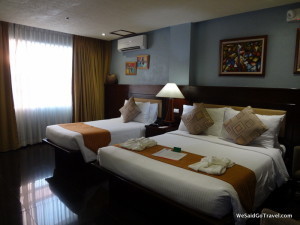
Constructed only two years ago in 2011, Hotel Centro has a variety of rooms to choose from including deluxe, superior, as well as honeymoon and family suites. The hotel puts on grill nights near the pool and has implemented an eco-friendly stance with programs to help the environment, such as their towel initiative; Hotel Centro was in fact awarded the 2011 Puerto Princesa City’s Cleanest and Greenest hotel award and is the 2012 Agoda.com Gold Circle Award.
The “Soul Pool Bar” offers Happy Hour discounts each night (60-peso local beers from 5 pm-8 pm; 50%-off margaritas and mojitos from 8 pm-11 pm) to help guests kick off evenings while relaxing at the bar adjacent to the pool and outdoor Jacuzzi. Hotel Centro’s amenities include a souvenir shop, fitness center, spa, business center and five conference venues. Fine dining is available for clients at Expressions Café but we had a romantic date night at Badjao Seafront, a highly recommended oceanside seafood restaurant where we sampled shrimp salad, crab soup and a tuna filet served with a side of vegetables and rice.

Navigating the underground river Puerto-Princesa Subterranean River National Park
After a comfortable night’s sleep, we departed to the underground river at Puerto-Princesa Subterranean River National Park, a UNESCO World Heritage Site and perhaps Palawan’s biggest tourist draw alongside El Nido. The underground river is also cited as number two of the New 7 Wonders of Nature. Formed by limestone karst formations, the underground river is open from 8:30 am-3:30 pm and issues 900 daily permits (which must be secured ahead of time; tour groups like AMIKA Tours can make the arrangements). We were picked up by April, a representative of AMIKA Tours, and en route we passed by Puerto Princesa’s largest mountain, Mt. Cleopatra. In keeping with Palawan’s theme of cleanliness and green eco-tourist stance, solar streetlights and trash free streets were evident.
READ THE FULL ARTICLE
The post Johnny Jet: Palawan, Philippines from Above and Below appeared first on We Said Go Travel.
Hyderabad India, A Cultural Delight
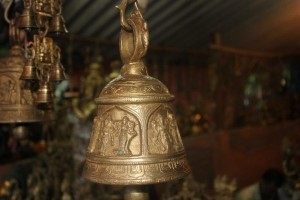 The delicate gold plated earrings stare back at me.
The delicate gold plated earrings stare back at me.
In the busy shopping centre at the crowded Bazaar, I breathe in the scent of Hyderabad.
People, walking around in search of useless things to buy crowd the narrow roads, hardly bothered about what they’re bumping into or whose feet they’re crushing underneath theirs. Middle aged ladies cling on to the tiny fingers of their terrified children as they push and shove their way through the unstopping masses of humans, trying to find the best deals. I look at those earrings again, hanging at the top on a block of cardboard, catching the fancy of a lot of women in front of me. I try to push forward, but either due to my lack of ability or my restricted upbringing, I watch sadly as the Khadi clad shopkeeper takes my dream pair out of display and hands them to a fair skinned Muslim lady. There is exchange of money and suddenly, the lady is gone, earrings and all.
My heart sinks.
I stop at a bangle store and get into it. I see long rainbow coloured shawls hanging from hooks and multiple shiny trinkets piled together.
“How much?” I ask the vendor, holding out a beautifully carved pair of green gold bangles.
He looks at me, analysing my economic background from my clothes.
“600” He says.
If I get this for 600 bucks, then I can’t buy those beautiful red beaded slippers at the shop opposite the street.
Maybe I can get both?
Or, maybe I’ll make do with my old slippers.
After a painful minute of mental math, I hold the bangles out to him.
“400” I say.
He shakes his head and tells me the price is fixed.
Then, without a moment’s pause, he starts packing them up for me.
I reach into my bag, bidding farewell to the slippers I wanted.
Just like before, a lady stops me.
“What are you doing?” She asks.
She looks nice, her hair plaited, her sari plain.
I shake my head, suddenly scared.
“This will hardly be worth a hundred bucks each” She says, shaking her head in disbelief and unwrapping my delicate bangles.
“I’m taking them” She says and hands him 200 bucks.
A few minutes later, I’m wearing my bangles and am trying out my new footwear.
Walking out of the bazaar, I start searching for a bus.
I’ve never been in a bus before. I thought, how hard can it be, right? Besides, it is really cheap and I’ve seen a lot of my friends use it.
But, I was totally wrong. I’ve never done anything harder. Three bags in my left hand, a pair of slippers clutched in my right, my handbag constantly running down my shoulder, I start running behind a bus.
One of the men who is hanging out of the bus, one foot on the step, the other in the air, hits hard on the body of the bus to stop it. It begins to halt and I run, panting, thanking the man with my eyes because I’m too tired to say anything. As I move to the front to get in, because the men are blocking the other entrance of the bus, I notice that the women are spilling out.
Shaking my head, I apologize to the driver, telling him I can’t get in because I have too many bags with me. He looks at me angrily and drives away. Even the man who helped me out looks peeved.
Feeling miserable, I decide to catch an auto instead.
Stopping the first auto that comes my way, I get in, telling him where I need to go.
“Two hundred” He says, holding up two fingers.
Looking out, I see a lot of spectacular things that I don’t think I’ll find in any other country.
I’m surrounded by unique greatness that astounds me.
People crowd around a Pani Puri stall, waiting for their turn for some of that delicious goodness. A tea vendor makes conversation with a customer, pocketing the cash he makes out of Garam Chai (Hot Tea) and Sambar Idlis. Overcrowded roads are filled with dented four wheelers, scratched two wheelers and buses that block the way, creating kilometres of blocked traffic jams.
Life here is hectic. But it is also fun.
I breathe in the polluted air of my city and I realize that this familiarity is what home feels like.
Over the pot-holes, the auto driver trundles, knowing he has made a good profit out of the money I’ve saved from all that bargaining.
The sun sets, only to rise again tomorrow for my imperfectly perfect city, diverse with cultures, tradition and languages.
I only have two words to describe what this place means to me.
My home.
About the Author: Shravya Gunipudi is a 20 year old CA Final Student from Hyderabad, India. Writing has been her passion right from a tender age and she has won numerous contests. She also has a blog titled ‘Fictionally Inkspired‘
The post Hyderabad India, A Cultural Delight appeared first on We Said Go Travel.
We Said Go Travel
We Said Go Travel is a global community of over sixteen hundred writers with articles from every continent.
Stories are shared with photos and video from a perspective of the transformative power of travel. We Said Go Travel has hosted live and online events as well as travel writing contests around the world. ...more
- Lisa Niver's profile
- 57 followers


